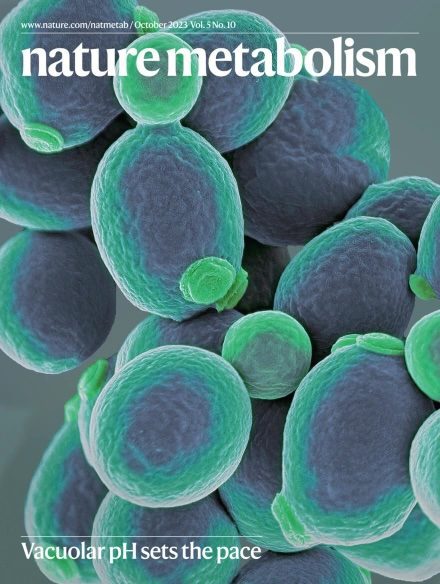Regulation of the cell cycle is of critical importance to the aging process. Proper cell cycle regulation ensures that cells divide when necessary and that damaged DNA is repaired before division. As we age, disruptions in the regulation of the cell cycle can lead to cellular senescence (when a cell stops growing but doesn’t die off), DNA mutations, and uncontrolled cell division, all of which are associated with age-related diseases and the general process of aging.
In the realm of mammalian cells, lysosomes are important to cell regulation playing a pivotal role akin to microscopic recycling plants. They are responsible for breaking down worn-out cellular components, eliminating damaged cells, and combating invading pathogens.
Scientists at Calico recently discovered new details about how the yeast vacuole, a research surrogate for mammalian lysosomes, plays an important role in the cell cycle process. They found that yeast vacuoles alter their pH —starting off slightly more acidic and becoming more basic during cell division— in a very specific pattern that adjusts the presence of certain protein building blocks known as amino acids.
This pH oscillation serves as an efficient means of moving amino acids to where they are needed, when they are needed, and helps to maintain homeostasis in the cell cycle process. It also ensures that no extraneous amino acids are present to get in the way of cell division. When the ability to change pH in the vacuole was disrupted, the Calico team found that yeast cells experienced dysfunctional growth and incorrectly timed division.
“What we found is that there is this additional aspect of translational control, governing how and when proteins are made so they’re not interfering with other cell cycle processes. It seems to be very important for storing amino acids and maybe other small molecules in a place, so they won’t interfere with chemistry that’s going on in the cell,” said Daniel Gottschling, Distinguished Principal Investigator at Calico who led the study. “Also, it turns out that everything we’ve discovered is conserved between yeast and humans.”
While the mechanism regulating that change was unknown, the effect of pH was clear: a persistent pH change had a negative impact on mitochondrial function. The Calico team believed characterizing this process more clearly could help shed new light on the mitochondrial dysfunction associated with aging in a broad range of organisms, including humans.
Scientific Serendipity
So how did such an important regulatory process go unnoticed all this time? Gottschling knew that the yeast vacuole shifted its pH from more acidic to more basic with age, but there was no tool available with the resolution necessary to carefully follow these changes.
The Calico team modified a microscopy-based fluorophore reporter used to study neurons to assess pH readings in yeast vacuoles. But even before that project could begin, they found something unusual when they put the fluorophore reporter into yeast. It blinked frequently.
“It turned out that the oscillations were very periodic when you studied one cell at a time,” Gottschling said. “In a micro colony, there were so many flashes all over that it looked like the Fourth of July.”
Caption: On the left side are cells growing and flashing the pH change. The right shows a trace measuring the flashing of two of the cells (circled in blue and orange).
What the research team had found was the previously unknown regulation of vacuolar pH that is linked to specific cell cycle timing and to the presence of particular amino acids. They were able to show that the pH changes were controlling the accumulation or release of amino acids in the vacuole, and that the process is regulated by highly conserved molecular pathways. When they blocked the yeast’s ability to change pH, it led to cellular dysfunction, producing daughter cells at the wrong times. The sequestration process they discovered is a very efficient way of moving amino acids based on changes in pH.
It was a classic example of scientific serendipity: discovering a novel biological process in an experiment designed to look for something else entirely.
To help advance this research, the Calico microscopy team has built a new pH sensor designed for lysosomes so scientists can further understand how the pattern spotted in yeast vacuoles is translated in mammalian cells.
Read the full article about this research, “Cell cycle-linked vacuolar pH dynamics regulate amino acid homeostasis and cell growth”, in Nature Metabolism.
